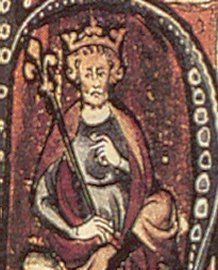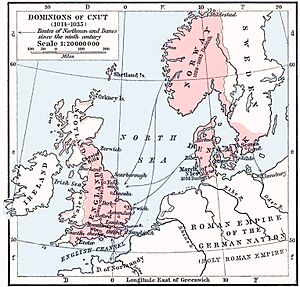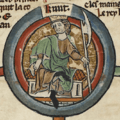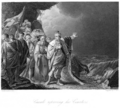Canute facts for kids
Quick facts for kids Cnut the Great |
|
|---|---|
| King of England, Denmark, Norway and a part of Sweden | |
 |
|
| Reign | England 1016-12 November 1035 Denmark 1018-12 November 1035 Norway 1028-1035 Part of Sweden 1028-12 November 1035 |
| Predecessor | Edmund Ironside (England) Harald II (Denmark) Olaf the Stout (Norway) Anund Jacob (Part of Sweden) |
| Successor | Harold Harefoot (England) Harthacanute (Denmark) Magnus I (Norway) Anund Jacob (Part of Sweden) |
| Born | ca. 985, 995 Denmark |
| Died | 1035 Shaftesbury, Dorset, England |
| Burial | Old Minster, Winchester, England. Bones now in Winchester Cathedral, England |
| Father | Sweyn I |
Cnut the Great (also spelled Canute) was a powerful Viking king who lived from about 995 to 1035. He ruled a huge empire that included England, Denmark, Norway, and even parts of Sweden. His power stretched across the North Sea region, making him one of the most important rulers of his time.
Cnut was the only person to be king of England, Denmark, and Norway all at once. He also had good relationships with important leaders like the Holy Roman Emperors and the pope.
Contents
Becoming King of England
In the summer of 1015, Cnut led a large Danish army to England. His fleet had about 200 longships and perhaps 10,000 Viking warriors. These Vikings came from all over Scandinavia.
For over a year, Cnut's forces fought against the English. Most of these battles were against Edmund Ironside, who was the son of the English king. After many struggles, Cnut became King of England in 1016. To make sure his rule was secure, he removed those who had opposed him.
Cnut's Family Life
Cnut was a Christian king and had two wives. His first wife was named Ælfgifu. Their marriage was a "handfast" one, which meant they joined hands in agreement. This was a legal way to marry at the time, even without a church ceremony. Ælfgifu stayed mostly in the northern parts of his kingdom.
His second wife was Emma of Normandy. Their wedding was a Christian ceremony. Emma was also sometimes called Ælfgifu in Old English. She lived in the southern part of the kingdom, with lands in Exeter.
Both of Cnut's wives had sons who later became kings of England. Cnut also gave many gifts to the Church, which helped him keep good relations with religious leaders.
Cnut's Children
- With Ælfgifu of Northampton:
- Sweyn Knutsson, who became King of Norway.
- Harold Harefoot, who became King of England.
- With Emma of Normandy:
- Harthacanute, who became King of Denmark and England.
- Gunhilda of Denmark, who married Henry III, the Holy Roman Emperor.
The Story of Cnut and the Waves
There's a famous story about Cnut that you might have heard. It says that he once sat on his throne by the sea and ordered the waves to stop. We don't know for sure if this really happened. The story comes from a writer named Henry of Huntington, who lived much later.
Henry of Huntington wrote that Cnut, who was a very powerful king, wanted to show his courtiers that even a king's power has limits. He ordered his chair to be placed on the seashore as the tide was coming in. Then, he commanded the rising tide, saying, "You are under my rule, just like the land I am sitting on. I order you not to come onto my land or wet my clothes!"
But the sea kept coming in, as it always does, and splashed Cnut's feet and legs. Cnut then jumped back and said, "Let everyone know that the power of kings is nothing compared to God's power! There is no true king except the one whose will the heavens, earth, and sea obey."
After this, the story says Cnut never wore his golden crown again. Instead, he placed it on a statue of Jesus, showing that he believed God was the greatest king of all. This story teaches us that even the most powerful people understand there are forces greater than themselves.
Images for kids
-
This runestone, U 194, mentions a Viking who won Knútr's payment in England.
-
Coins of Cnut the Great, from the British Museum.
-
More coins of Cnut the Great, from the British Museum.
-
Even more coins of Cnut the Great, from the British Museum.
-
Angels crown Cnut as he and Emma of Normandy (also called Ælfgifu) give a large gold cross to Hyde Abbey in Winchester.
See also
 In Spanish: Canuto II de Dinamarca para niños
In Spanish: Canuto II de Dinamarca para niños












